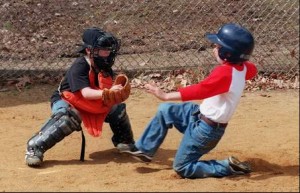Wednesdays Web Gems
Coaching Baseball Catchers - The Basics of Catching
A common statement goes like this, "Teams only go as far as their pitching takes them." In youth baseball, the case may be that teams only go as far as their catching takes them. Unfortunately, baseball catching fundamentals and technique is an area youth baseball coaches know least about. Good youth coaches should at least learn the basics of catching, as good catching sets the tone for the whole game.
Coaching Basics of Catching Communication 
The catching position is usually the means of communication from the coach to the field. Because the catcher has the whole field in front of him, they have the easiest opportunity to relay signals from the bench to players on the field. The following signals from coaches to players go through the catcher:
- When the pitcher should throw to bases to hold runners close
- What play to run for possible sacrifice bunt situations ( or signal goes to 3rd baseman)
- What play to run on possible double steal plays
- When the catcher should go out and calm the pitcher down
Although, I believe catchers should learn to call the pitcher's pitches, sometimes it is necessary for coaches to call pitches from the bench, also. Good catchers learn to lead teams through their actions and enthusiasm, which are characteristics coaches help develop.
Coaching Basics of Catching Fundamentals
Once again, youth coaches cannot be expected to know the finer points of baseball catching, but they should know some basics to help.
- Stance When using signs, catchers begin on balls of feet, with knees pinched together so only pitcher and middle infielders see pitch signs. After giving sign, feet widen for balance so not on tiptoes of feet, with rear end low. Rear end moves slightly higher with runners on base
- Target low glove position that is around knee high with glove extended away from body towards pitcher to a comfortable position. Coaches should make surecatchers are not blocking their eyes with their glove position.
- Bare hand is set behind their throwing side foot for protection from the ball
Coaching Basics of Catching Key Responsibilities
- Receiving the Ball Number one goal of catchers is to catch the ball in a manner that makes strikes and pitches close, called strikes. This catching technique is what is known as "framing" the ball. This takes soft hand and the above catching fundamentals, along with years of practice so the glove does not move when catching the ball. A great way to coach this is to have catchers catch Frisbees with their bare glove hand, thrown at them from a short distance. To catch the Frisbee, they will just squeeze it in the spot, which is what framing is all about.
- Throwing footwork is key here, which is all set up by the good, balanced stance and low glove position with the catcher's fundamentals. Coordinating a quick transfer of ball from glove to hand, by zipping the glove directly across the chest area to the back ear as the feet shift to throwing position, is the key to a quick, strong throw. Beginning with short distance flips to catchers, is the best way to help them gain this technique, before gradually moving back to the pitching distance.
- Blocking balls in the dirt maybe the toughest responsibility for young catchers to learn is the blocking technique that prevents balls form continually getting past them. Catchers must drop to both knees, while the glove goes between the knees, leaving no gap for the ball to get by. The toughest thing for youth catchers is to understand their first objective is to block the ball and not catch it. This approach means the ball should hit the catcher's chest protector, or glove, in a way that the blocked ball falls directly in front of them. Attempting to catch the ball instead, means catchers raise their glove, which often leads to balls going through their feet. This technique is best begun with using softer type balls first, so catchers learn the technique before moving to hard balls, so they can get over their fear of injury.
Once again, these are just the basics of catching that youth coaches should know. For more expertise, coaches should have players work with an experience baseball-catching specialist.


chandler allen says:
"Hi my name is chandler, i’ve enjoyed..."
On Wanting to tryout for summer ball. as an 18 year old
david graham says:
"With no current MLB team in Canada,..."
On With no current MLB team in
Charles Chavez says:
"To All Coaches: Do you have13U or..."
On Looking for Games